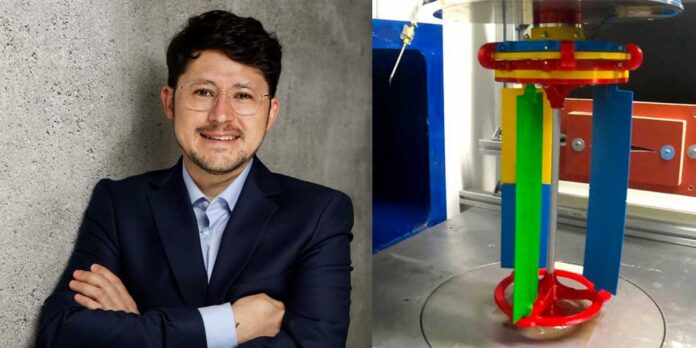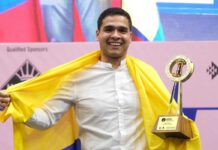A turbine for domestic use, developed between Colombia and Germany, could electrify homes starting in 2024. The story of its creator reflects the challenges of inventors in Latin America.
The engineer and entrepreneur Alirio Jimenez Franco has developed a prototype wind turbine for domestic use that can sustainably meet the energy needs of those without access to electrical grids. This is the Vertical Axis Wind Turbine (TEEV). Its design allows it to generate energy from low-speed winds (18 km/h) and operate in both rural and urban spaces. Currently, the Colombian inventor is fine-tuning details of the most recent version of the prototype in Germany, while looking for investors interested in producing his invention on an industrial scale. This turbine could reach the markets of Colombia and Germany during 2024.
The TEEV was designed to charge the batteries of mobile electronic devices such as cell phones or computers in places with little or no access to the electrical grid. Its 3 blades can adjust their position by rotating on themselves and rotate parallel around the axis, located in the center and perpendicular to the ground. This allows them to take advantage of wind currents coming from all directions. Inserts in the base of the turbine, neodymium magnets and copper wire convert movement into electricity.
Although the turbine has not yet been able to replace other sustainable energy generating devices, such as solar panels, it serves as a complement to them on cloudy nights or days. Even so, its use could equally serve digital nomads such as those 2% of Colombian homes that, according to DANE, still do not have electricity. According to the Colombian inventor, homes located near the sea or on the Andes mountain range could benefit from his turbine.
Inventor and transnational entrepreneur
Jiménez left Colombia to settle in Germany, where he obtained financing for his turbine. After finishing his studies as a mechanical engineer, the Colombian inventor traveled to Cologne to pursue a master's program in renewable energy. Years of work in the form of diagrams, plans and ideas traveled with him. Thus, in 2019, five years after conceiving the first version of the turbine, he was the winner of the Business Ideas for Development call, organized by the German government's Development Cooperation Agency (GIZ). In the words of David Betancur, technical advisor of the Migration and Diaspora program at the GIZ, “this mechanism is aimed at Colombians who are in Germany, so that they come to create companies, generate employment here in Colombia and contribute to the economic development of the country. .”
In addition to receiving financing to complete the TEEV prototype and advice for creating a company, Jiménez was put in contact with the Tecnoparque Network. This technological innovation program of the Colombian State accompanies the development of innovative products. With their support, the inventor built a full-size prototype. Likewise, performance tests were carried out in the laboratory and outside of it. According to Esteban Ocampo, promoter of the Tecnoparque Rionegro, the objective of these tests is “to be able to measure the performance of the turbine and validate all the construction processes so that it can be brought to the market.” Although the testing phase could be completed in the course of 2023, the patent certificate for the turbine is still pending.
The production of sustainable energy from renewable sources such as wind or the sun is a common interest of the governments of Germany and Colombia. For this reason, TEEV received support from entities in both countries. Manufactured on 3D printers, most turbine parts can be made from recycled plastic and reprinted in case of breakdown. This reduces its carbon footprint in addition to extending its useful life. Small energy generators like this could counteract the shortcomings in the quality of electricity service that homes in Colombia receive, without the social and environmental impacts unleashed by large-scale installations, such as the La Guajira wind farms.
The challenges of inventors in Colombia
After 10 years of work, the first TEEV model is close to hitting the market, however, it is not possible to predict when since Jiménez can only work on it during his free time. “If I could dedicate 100% of my time to it I could do it in about two months. But it is a bit utopian, since I have to work here to pay my bills, that is, I work full time for a company,” says the inventor. Just like him, other inventors are torn between their jobs and their technological innovation projects in Colombia. Costing the development of innovative products, from their conception to their production phase on an industrial scale, is, according to Ocampo, one of the challenges that most face.
Just like Jiménez, a good part of the inventors in Latin America decide to leave their countries and some time later register their inventions from abroad. According to the indicators report for 2022 from the World Intellectual Property Organization, more than 80% of patent applications in the Colombian registry office were made from abroad. Other countries in the region such as Argentina, Ecuador, Brazil and Mexico record similar figures.
Original source: dw.com





